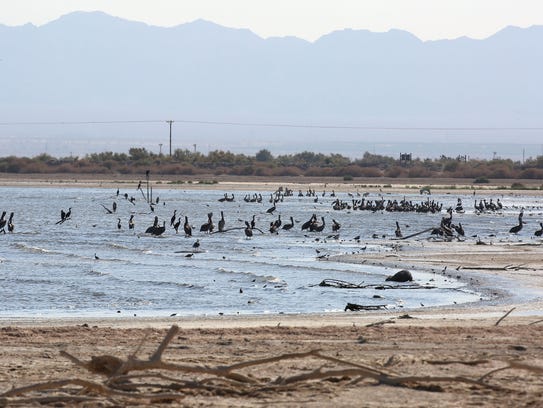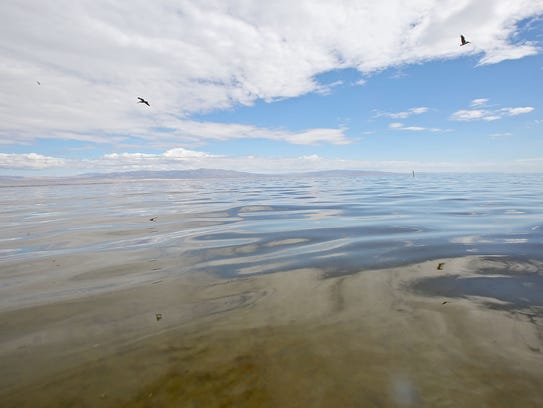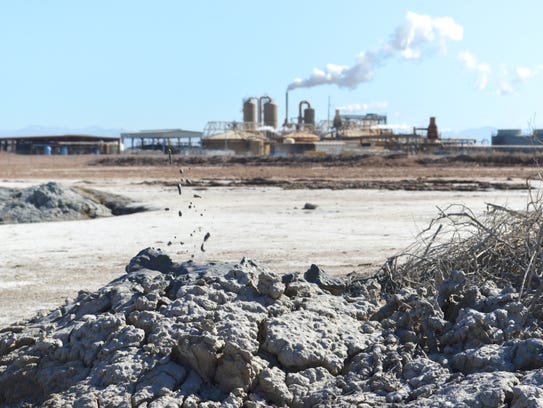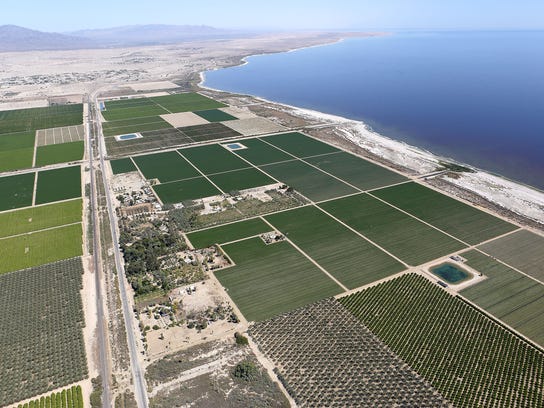
(Photo: Ron Holman/The Visalia Times-Delta)
The federal government is stepping up its commitment to the Salton Sea and exploring the possibility of buying geothermal energy from the Imperial Valley, in a series of moves that could help fund restoration projects at California's largest lake and maybe pave the way for a multi-state agreement to use less Colorado River water...
The White House unveiled those plans Wednesday, as President Barack Obama traveled to Lake Tahoe for the 20th annual Lake Tahoe Summit. The new Salton Sea initiatives include:
- A $30 million funding commitment from the federal government, part of a state-federal agreement designed to speed up projects that protect human health and the environment;
- A "request for information" through which the federal government will explore whether it can buy between 100 and 250 megawatts of geothermal power from the Salton Sea area;
- Possible funding from a nonprofit called the Water Funder Initiative, which has set a goal of providing $10 million over five years to support Salton Sea restoration.
During his remarks Wednesday, Obama focused on Lake Tahoe and the importance of fighting climate change. He mentioned the Salton Sea in passing, telling summit attendees, "We’re going to reverse the deterioration of the Salton Sea before it's too late, and that's going to help a lot of folks all across the West."
THE CURRENT: Subscribe to The Desert Sun's energy and water newsletter
The White House's interest in the Salton Sea comes at a precarious time for the beleaguered lake, which is shrinking as farm runoff declines. As dry lakebed is exposed, gusting winds are kicking up dust laced with pesticides and other chemicals, polluting the desert air. Fish are dying en masse as the lake gets too salty to support much life, and migrating birds that travel from Alaska to South America are seeing a critical inland stopover start to disappear. The Pacific Institute, a water think tank, has estimated Californians could face up to $70 billion in costs as the lake breaks down.

Thousands of birds roost at the Sonny Bono National Wildlife Refuge at the Salton Sea on Aug. 5, 2016. (Photo: Jay Calderon/The Desert Sun)
Local agencies and state officials are working on Salton Sea management plans, which mostly involve building artificial wetlands to suppress dust and provide habitat for fish and birds. But while a few of those projects have gotten underway, most of them are still in the planning stage, and nobody knows where all the money will come from. The White House hopes to jump-start the process.
"Today's announcement demonstrates that smart and strategic action in Salton Sea can unlock significant public health, environmental, and economic wins for the region," Brian Deese, a senior advisor to Obama, said in a statement.
The centerpiece of Wednesday's announcements was a memorandum of understanding between the federal Interior Department and the California Natural Resources Agency. The document commits the federal government to spending $30 million at the Salton Sea over the next decade: $20 million to support the operation and maintenance of restoration projects, and $10 million for monitoring environmental conditions at the lake. That money will add to the $80.5 million budgeted by state lawmakers earlier this year.
More broadly, the agreement calls for the federal and state governments to speed up restoration work, in an effort to build between 18,000 and 25,000 acres of habitat and dust suppression projects by 2025 — an ambitious goal already set by the state. But aside from short-term funding promises, the agreement is low on specifics. It says federal and state agencies will "make every effort to ensure resources are allocated to expedite and prioritize permitting processes," but it doesn't say how. And it doesn't address long-term management plans, which could cost more than $3 billion.
RELATED: Obama burnishes environmental legacy at Lake Tahoe
But Bruce Wilcox, who oversees Salton Sea policy for the California Natural Resources Agency, is optimistic. He described the memorandum as a "big step," in part because the federal government has signed on to specific Salton Sea management actions for the first time. He pointed to the funding promises, and to a pledge of continued scientific and technical support for Salton Sea projects from the U.S. Geological Survey. The federal agency has been instrumental in helping manage selenium levels in the lake, among other projects, Wilcox said.
"These are very specific things that over the course of the last week and a half, we negotiated with the feds," he said. "In the past we’ve suffered from this (thing where) everybody around the table says, 'I’ll support coordinating future efforts at the Salton Sea.' That’s a pretty easy thing to agree to. This (agreement) — with the specifics that are in it — I think everybody means it."

(Photo: Jay Calderon/The Desert Sun)
Part of the reason for signing the agreement now, Wilcox added, is to shore up federal support before the next presidential administration — no matter who wins the November election.
"There’s language in there that allows anybody to bow out at any point, but I'm fairly confident that's not going to happen," he said.
READ MORE: At Salton Sea, political pressure finally spurs progress
The Department of Energy's request for information on geothermal development could signal an even bigger sea change.
The rock formations beneath the Salton Sea contain one of the most powerful geothermal reservoirs in the world, and local agencies, including the Imperial Irrigation District, have long argued that fees paid by geothermal companies could help fund Salton Sea restoration. But geothermal development has largely stalled in recent years, due to the technology's high up-front costs.
Geothermal advocates have criticized the California Public Utilities Commission, which administers the state's renewable energy mandate, saying the agency has under-valued geothermal and stymied its development. While building the facilities is expensive, those critics say, geothermal plants provide climate-friendly energy around the clock, balancing out intermittent solar and wind power.

Mud bubbles out of the ground as EnergySource's Featherstone geothermal power plant belches steam in the distance on April 29, 2016. It's one of 11 geothermal plants by the southern shore of the Salton Sea. (Photo: Robert Hopwood/The Desert Sun)
If the federal government ultimately buys geothermal energy from the Salton Sea, it could "break the deadlock" and help spark a geothermal building boom, said V. John White, executive director of the Center for Energy Efficiency and Renewable Technologies, a Sacramento-based trade group.
"We've got to start somewhere," White said.
READ MORE: At Salton Sea, dreaming big on geothermal
The White House's involvement in Salton Sea restoration also bodes well for ongoing Colorado River negotiations between California, Arizona and Nevada. The three states hope to share in cutbacks so as to avoid a looming shortage at Lake Mead, the nation's largest reservoir. If they agree to use less river water now, the thinking goes, they could avoid federally mandated reductions later.
But any agreement to use less Colorado River water will probably require buy-in from the Imperial Irrigation District, which provides enormous amounts of river water to Imperial Valley farms. Less water flowing to those farms would also mean less runoff trickling into the Salton Sea, potentially accelerating its decline. Irrigation district officials are loathe to support a Colorado River deal without firm commitments from the state and federal government to address the Salton Sea, and a concrete plan for following through on them.
“I think there is a real opportunity for the Colorado River community, the federal government, and the state of California to make some real headway on this longstanding problem of what to do about the Salton Sea, and I think that opening is right now," Kevin Kelley, the district's general manager, said in an interview last week.
READ MORE: Lake Mead declines to lowest level in history
Kelley was cautious Wednesday following the signing of the memorandum, saying in an emailed statement the district is "supportive of any efforts that marshal long-term coordination between the State and Federal government that will speed up mitigation projects that will protect human health and the environment." A district spokesperson said it's not yet clear whether Wednesday's agreement will adequately address the agency's concerns about the Salton Sea and the Colorado River negotiations.

(Photo: Jay Calderon/The Desert Sun)
Then there's the $10-million funding goal from the Water Funder Initiative, a nonprofit backed by philanthropic organizations including the S.D. Bechtel, Jr. Foundation, the Energy Foundation, the Cynthia and George Mitchell Foundation, the Walton Family Foundation and the Water Foundation. The group's goal is to support sustainable water management projects, especially in the American West, and it sees the Salton Sea as a critical piece of the Colorado River puzzle, said Ted Kowalski, director of the Walton Family Foundation's Colorado River initiative.
The Water Funder Initiative described the $10 million as a "goal" rather than a "commitment" because it's contingent on state and federal officials developing a comprehensive Salton Sea plan. The initiative's backers are looking for a plan that addresses air pollution in disadvantaged communities, habitat loss, clean energy development in the Imperial Valley and better water management across the Colorado River basin. That plan should include "sufficient funding commitments from the State of California and the Federal government," the initiative said in a statement.
Wilcox said the foundation money could help pay for environmental monitoring and the development of a long-term management plan. Kowalski is hopeful the money will contribute to "real progress on the ground," in coordination with state and federal dollars.
"It's a looming environmental disaster, but it's a huge opportunity to basically assure sustainable management on the Colorado River system, if we can come together and figure out these issues," Kowalski said.
READ MORE: Jerry Brown announces 25,000-acre restoration goal
The White House also said Wednesday that a $7.5 million Salton Sea grant from the Department of Agriculture, which was announced earlier this year, is close to being finalized. That money will go to the Salton Sea Authority, a local agency whose board includes representatives from water providers, county governments and the Torres Martinez Desert Cahuilla Indians.
Among other uses, the $7.5 million grant could go toward helping farmers adopt organic practices that don't use pesticides or synthetic fertilizers, said Phil Rosentrater, executive director of the Salton Sea Authority. That would mean fewer chemicals polluting the lake and later being blown from the dry lakebed into the Southern California air. The money could also be used to convert exposed lakebed into cropland, keeping down dust. The goal is to back projects that can simultaneously improve air quality, water quality and wildlife habitat.
"We really want to make sure we achieve as many benefits with a single influx of public money as possible. One thing we don't have is an excess of money, or an excess of time," Rosentrater said.

Farmland and Highway 111 run along the Salton Sea’s northern shore. (Photo: Jay Calderon/The Desert Sun)
Still, it's far from clear how much the initiatives being announced Wednesday will help in the long run. State officials have said their work-in-progress Salton Sea Management Program could cost as much as $3.5 billion, and it's not clear where the bulk of that money will come from. Some experts don't think geothermal can play a major role in Salton Sea restoration, including researchers at the National Renewable Energy Laboratory, who estimated last year the industry could generate at most $210 million for restoration efforts by 2030, largely because development is already so expensive.
Recognizing the high costs of building a geothermal plant, the White House announced $29 million in funding from the Department of Energy for geothermal research projects in Nevada and Utah on Wednesday. That work, in theory, could bring down the costs of development. The department will also host a forum on Salton Sea geothermal development in October, in Sacramento.
READ MORE: Sen. Boxer calls for quicker action on the Salton Sea
Whatever comes next for California's largest lake, time is short.
For the last dozen years, the Imperial Irrigation District has replenished the Salton Sea with "mitigation water" direct from the Colorado River, which it's receiving as compensation for agreeing to send 10 trillion gallons of water to the Coachella Valley and San Diego County over 75 years, as part of a huge farm-to-city water transfer deal. But that mitigation water is set to run out Jan. 1, 2018.
That means in just under 500 days, the lake will start shrinking even faster.
Ian James contributed to this report.
Sammy Roth writes about energy and the environment for The Desert Sun. He can be reached at [email protected], (760) 778-4622 and @Sammy_Roth.
To help do something about the climate change and global warming emergency, click here.
Sign up for our free Global Warming Blog by clicking here. (In your email, you will receive critical news, research, and the warning signs for the next global warming disaster.)
To share this blog post: Go to the Share button to the left below.

Be the first to comment
Sign in with